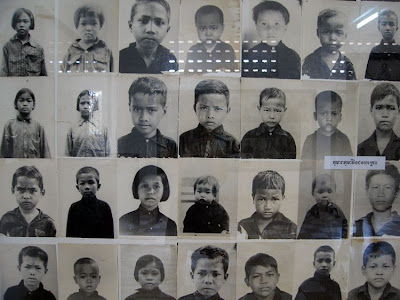S-21, Prelude to the Killing Fields
Tuol Sleng, in the Cambodian capital of Phenom Penh, was once a secondary school but was turned into a prison during the reign of the Khmer Rouge. Now it stands much as it was when it was discovered and made into a genocide museum. The Khmer Rouge favored the base people that worked the fields so they forced the people of privilege, essentially city dwellers, into the countryside to work sixteen hour days. In this way Phenom Penh was deserted for 4yrs. Though there wasn’t enough food to eat they were forced to continue the hard labor. Many died of disease, hunger, and torture. Our guide was ten years old when her family of ten were kicked out of the city on liberation day, April 17, 1975. She and her siblings were sent to the childrens’ camp to work. She heard her father died of starvation. Two of her brothers and one sister also died during that regime. She never found out what happened to her grand parents. An all too common story as the Khmer Rouge separated families without explanations. Individuals would be taken away in covered trucks for no known reason and never seen again. Even after Pol Pot, the teacher turned Khmer Rouge leader, was ousted people still had no idea what happened to their families. To this day many Cambodians have family members that they have no idea what happened to. People were taken from all walks of life; villagers, teachers, foreigners, journalists, soldiers, Khmer Rouge officials. No one was safe from Pol Pot’s paranoia. They would be taken with no explanation to prisons like S-21 where they would be catalogued, questioned, and photographed. Everyday three to seven hundred people would pass through the barbed gates. They would be tagged, and if they came shirtless then the numbers would be pinned to their skin. Then they would be tortured for confessions. They were chained in small cells or en masse on the floor, not allowed to move unless they asked for permission first. Tin cans and plastic jugs were used as communal toilets. Every disobeyance was met with slashes. People would be tortured to death or sent to the killing fields after the Khmer Rouge were done questioning them. Even the wives, children, cousins, parents, and neighbors of the prisoners were brought in and killed systematically. People were held here from one to six months, arms and legs chained to the ground so they couldn’t move. Many were grabbed from their villages, a sack thrown over their heads only to see a camera staring them down when the bag was removed. Each person had their own file and were photographed upon entry.  It was this cataloging that four thousand pictures were recovered as well details of the treatment of the prisoners. Looking at those ghostly final photos was like looking at fear itself. Those faces were full of defeat and the eyes spoke of horror. The instruments of terror still remained as did blood stains on the floor. The Khmer Rouge had enlisted teenagers to guard and torture the prisoners. Any that showed weakness, sympathy, or disobedience became a prisoner themselves. In the end no one was ever held accountable for the atrocities and now the leaders of Cambodia are the same Khmer Rouge officials. We heard from several locals that the young generation, those born after the end of the atrocities, is neither interested nor wholly believe that it happened. Their attention is focused on western fads and the latest Nokia phone. Of the estimated 17,000 imprisoned in S-21 only 7 survived.
It was this cataloging that four thousand pictures were recovered as well details of the treatment of the prisoners. Looking at those ghostly final photos was like looking at fear itself. Those faces were full of defeat and the eyes spoke of horror. The instruments of terror still remained as did blood stains on the floor. The Khmer Rouge had enlisted teenagers to guard and torture the prisoners. Any that showed weakness, sympathy, or disobedience became a prisoner themselves. In the end no one was ever held accountable for the atrocities and now the leaders of Cambodia are the same Khmer Rouge officials. We heard from several locals that the young generation, those born after the end of the atrocities, is neither interested nor wholly believe that it happened. Their attention is focused on western fads and the latest Nokia phone. Of the estimated 17,000 imprisoned in S-21 only 7 survived.
Posted in cambodia | No Comments »
